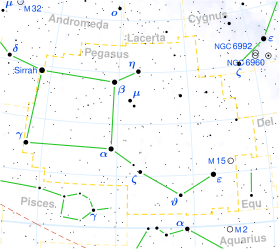2 Pegasi
| Observation data Epoch J2000 Equinox J2000 | |
|---|---|
| Constellation | Pegasus |
| Right ascension | 21h 29m 56.89545s[1] |
| Declination | 23° 38′ 19.8170″[1] |
| Apparent magnitude (V) | 4.52[2] |
| Characteristics | |
| Spectral type | M1+III[3] |
| U−B color index | +1.93[4] |
| B−V color index | +1.62[4] |
| Astrometry | |
| Radial velocity (Rv) | -18.92[5] km/s |
| Proper motion (μ) | RA: +24.74[1] mas/yr Dec.: +3.63[1] mas/yr |
| Parallax (π) | 8.28 ± 0.18[1] mas |
| Distance | 394 ± 9 ly (121 ± 3 pc) |
| Absolute magnitude (MV) | -0.89[2] |
| Details | |
| Luminosity | 581[6] L☉ |
| Temperature | 3,949[6] K |
| Other designations | |
| Database references | |
| SIMBAD | data |
2 Pegasi is a class M1III[3] (red giant) star in the constellation Pegasus. Its apparent magnitude is 4.52[2] and it is approximately 394 light years away based on parallax.[1]
It is a binary star with one companion, B, at a separation of 30.4" and magnitude 12.7.[7]
References
- 1 2 3 4 5 6 Van Leeuwen, F. (2007). "Validation of the new Hipparcos reduction". Astronomy and Astrophysics. 474 (2): 653. arXiv:0708.1752. Bibcode:2007A&A...474..653V. doi:10.1051/0004-6361:20078357. Vizier catalog entry
- 1 2 3 Anderson, E.; Francis, Ch. (2012). "XHIP: An extended hipparcos compilation". Astronomy Letters. 38 (5): 331. arXiv:1108.4971. Bibcode:2012AstL...38..331A. doi:10.1134/S1063773712050015. Vizier catalog entry
- 1 2 Hoffleit, D.; Warren, W. H. (1995). "VizieR Online Data Catalog: Bright Star Catalogue, 5th Revised Ed. (Hoffleit+, 1991)". VizieR On-line Data Catalog: V/50. Originally published in: 1964BS....C......0H. 5050. Bibcode:1995yCat.5050....0H.
- 1 2 Mallama, A. (2014). "Sloan Magnitudes for the Brightest Stars". The Journal of the American Association of Variable Star Observers. 42: 443. Bibcode:2014JAVSO..42..443M. Vizier catalog entry
- ↑ Famaey, B.; Pourbaix, D.; Frankowski, A.; Van Eck, S.; Mayor, M.; Udry, S.; Jorissen, A. (2009). "Spectroscopic binaries among Hipparcos M giants". Astronomy and Astrophysics. 498 (2): 627. arXiv:0901.0934. Bibcode:2009A&A...498..627F. doi:10.1051/0004-6361/200810698.
- 1 2 McDonald, I.; Zijlstra, A. A.; Boyer, M. L. (2012). "Fundamental parameters and infrared excesses of Hipparcos stars". Monthly Notices of the Royal Astronomical Society. 427: 343. arXiv:1208.2037. Bibcode:2012MNRAS.427..343M. doi:10.1111/j.1365-2966.2012.21873.x. Vizier catalog entry
- ↑ Mason, Brian D.; Wycoff, Gary L.; Hartkopf, William I.; Douglass, Geoffrey G.; Worley, Charles E. (2001). "The 2001 US Naval Observatory Double Star CD-ROM. I. The Washington Double Star Catalog". The Astronomical Journal. 122 (6): 3466. Bibcode:2001AJ....122.3466M. doi:10.1086/323920. Vizier catalog entry
This article is issued from
Wikipedia.
The text is licensed under Creative Commons - Attribution - Sharealike.
Additional terms may apply for the media files.
